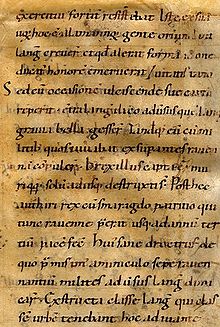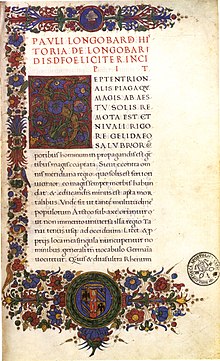Historia gentis Langobardorum


The Historia gentis Langobardorum ( History of the Longobards ) is the main work of the Longobard monk Paulus Diaconus († probably before 800), which he wrote towards the end of his life. In his work, Paul tries to present the story of a Germanic gens, the Lombards, according to the principles of ancient historiography , and in addition to legends, he offers numerous references to the pre-Christian religion of the Lombards. The work ends with the death of King Liutprand in the year 744. As virtues of his people, he mentions above all "courage, devotion to his leaders, sense of honor". Paul, who lived at the Frankish court for a long time, does not depict the downfall of the empire by the Franks , which he attributes to the neglect of religion by the Lombard rulers. The work has been copied many times, and more than a hundred copies have survived.
Time and place of writing, occasion, content
The history in six books was written after 787 and not later than 796, because Paul never mentions the smashing of the Avar empire in that year by one of the sons of Charlemagne . Paul probably wrote in Montecassino , because he mentions in his work that he worked on the first book in the monastery there (I, 26), as well as on the last (VI, 2 and 40). The author also mentions in several places that he wrote the opus after his return from the Frankish Empire . The work lacks the usual dedication , as well as the prologue and epilogue . The thesis that he did not describe the downfall of the Lombard Empire out of pain is considered untenable, since he does mention the Lombard guilt for it (V, 6), as well as that of the Popes (IV, 29).
According to a thesis by Rosamond McKitterick , the work was possibly created on the initiative of Charlemagne and his son Pippin in order to improve knowledge of the Lombards and the mutual understanding between them and the victorious Franks. The spread can be proven by means of early chronicles, such as in Naples or Salerno .
The Historia encompasses the history of the Lombards from their mythical beginnings in Scandinavia to the death of King Liutprand and describes numerous processes and conditions in the Eastern Roman-Byzantine Empire , among the Franks and other power groups. The story is presented from a Longobard perspective, the dynasty in particular offers orientation. In contrast to the Franks, there is no connection between the Empire and the papacy. Paulus Diaconus focuses on the relations between Franks and Lombards. He takes a clear position against the iconoclasm emanating from Constantinople . Against the disparagement by the popes, he uses a deliberately written work in Latin , with which his audience apparently encompassed more than just the Lombards. All gentes should be united by faith (I, 4); the fault of the Lombards, which eventually led to their downfall, was for neglecting religion.
Paul used the Origo Gentis Langobardorum , the Liber pontificalis , the lost Historiola des Secundus of Trento and the also lost annals of Benevento as sources . He made free use of Beda Venerabilis , Gregory of Tours and Isidore of Seville .
Editions
About one hundred manuscripts have survived from the Historia . It was often used by later authors and often supplemented. The work was published in excerpts in Rome in 1471. The first printed edition appeared in 1480 by Antonio Miscomini in Florence, the first in France in 1514 in Paris. The best Latin edition is that by Ludwig Bethmann and Georg Waitz in the Monumenta Germaniae Historica .
- Paulus Diaconus: Historia Langobardorum , in: Ludwig Bethmann, Georg Waitz (ed.): Scriptores rerum Langobardicarum et Italicarum saec. VI-IX. Hanover 1878, pp. 12–187 ( Monumenta Germaniae Historica , digitized version ) ( digitized version from the Digital Monumenta )
- Text based on the MGH edition in the "Sources on the Longobard History" of the Institute for Medieval Research (IMAFO) of the Austrian Academy of Sciences
- Transcription of the MGH text in the Bibliotheca Augustana
- Lidia Capo (ed.): Storia dei Longobardi , Fondazione Lorenzo Valla, Milan 1992. (Latin-Italian)
Translations
- Otto Abel : Des Paulus Diakonus history of the Lombards , in: Ders .: Paulus Diakonus and the other historians of the Lombards , Berlin 1849, p. 11ff. ( Digitized version )
- Otto Abel (translator), Alexander Heine (ed.): History of the Lombards - Paulus Diakonus and the historians of the Lombards , Phaidon-Verlag, Essen 1992, ISBN 978-3-888-51097-7 (reprint of the Leipzig 1878 edition) ( Digitized version of the first edition, Berlin 1849, on Google Books ).
- Wolfgang F. Schwarz (Ed.): Paulus Diaconus: Historia Langobardorum - History of the Longobards , Scientific Book Society, Darmstadt 2009. ISBN 978-3-534-22258-2
literature
- Ernesto Sestan : La storiografia dell'Italia longobarda: Paolo Diacono , in: La storiografia altomedievale, Settimane di Studio del CISAM, 17 , Spoleto 1970, pp. 357-386.
- Florus van der Rhee: The Germanic words in the “Historia Langobardorum” of Paulus Diaconus , in: Romanobarbarica V (1980) 271-296.
- Karl Heinrich Krüger : On the 'Beneventan' conception of the Longobard history of Paulus Diaconus , in: Frühmittelalterliche Studien XV (1981), 18–35.
- Donald Auberon Bullough: Ethnic history and the Carolingians: an alternative reading of Paul the Deacon's “Historia Langobardorum” , in: Ders. (Ed.): Carolingian renewal. Sources and Heritage , Manchester 1991, pp. 97-122.
- Walter Pohl : Paulus Diaconus and the "Historia Langobardorum". Text and tradition , in: Anton Scharer , Georg Scheibelreiter (eds.): Historiography in the early Middle Ages, Symposion Zwettl 1993 , Vienna 1994, pp. 375–405.
- Florin Curta : Slavs in Fredegar and Paul the Deacon: medieval gens or “scourge of God”? , in: Early medieval Europe VI (1997) 141-167.
- Paulus Diaconus , in: Benedetta Valtorta (Ed.): Clavis Scriptorum Latinorum Medii Aevi. Auctores Italiae (700-1000) , Florence 2006, pp. 196-219.
- Pedro P. Herrera Roldán: Pablo Diacono. Historia de los Longobardos , Cadíz 2006.
- Alheydis Plassmann : Medieval origines gentium. Paulus Diaconus as an example , in: Sources and research from Italian archives and libraries LXXXVII (2007) 1–35 ( online ).
- Walter Pohl: Heresy in Secundus and Paul the Deacon , in: Celia Martin Chazelle, Catherine Cubitt (Ed.): The Crisis of the Oikoumene. The Three Chapters and the failed Quest for Unity in the Sixth-Century Mediterranean , Turnhout 2007, pp. 243-264.
- Christopher Timothy Heath: Narrative Structures in the Work of Paul the Deacon , PhD, Manchester 2013. ( online )
Web links
- Works of Paulus Deacon at Bibliotheca Augustana (in Latin).
- Historia Langobardorum , entry in the repertory "Historical Sources of the German Middle Ages".
- Historia Langobardorum , overview and complete reproduction of the Codex: Cividale del Friuli, Museo Archeologico Nazionale, XXVIII.
Remarks
- ↑ The beginning of the text reads: “[In qua Droctulft dux Langobardis confugerat seque partibus imperatoris tradens sociatus militibus, Langobardorum] exercitui fortiter resistebat. Iste ex Suavorum hoc est Alamannorum gente oriundus inter Langobardos creverat et quia erat forma idoneus ducatus honorem meruerat /… “.
- ↑ Stefano Gasparri: Paulus Deacon . In: Lexicon of the Middle Ages (LexMA). Volume 6, Artemis & Winkler, Munich / Zurich 1993, ISBN 3-7608-8906-9 , Sp. 1825 f.
- ^ Rosamond McKitterick : Paul the Deacon's Historia Langobardorum and the Franks , in: Dies (ed.): History and Memory in the Carolingian World , Cambridge 2004, pp. 60-83.
- ↑ digitized version .
